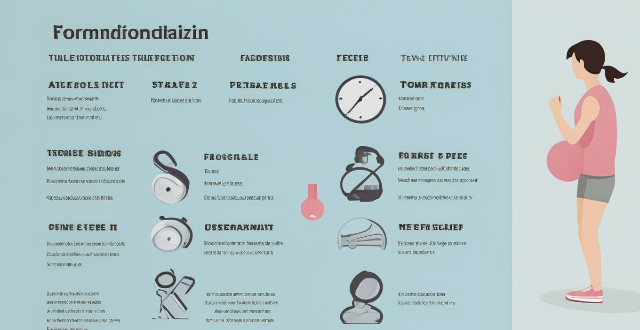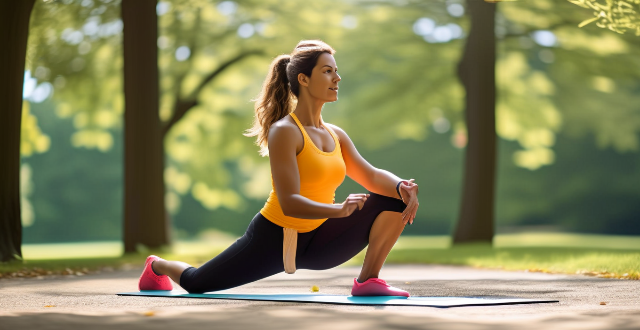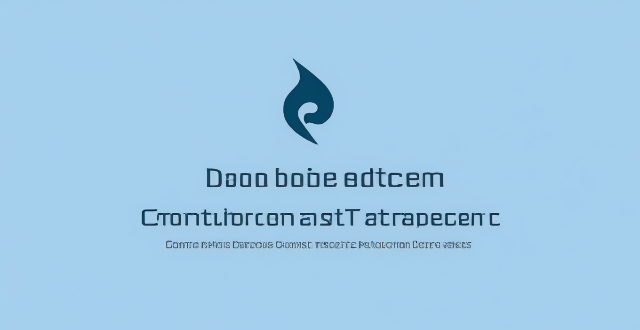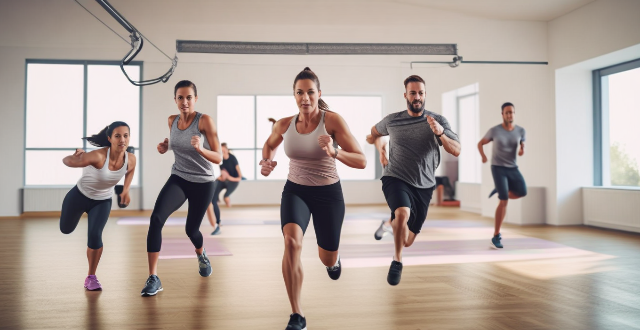Endurance Training

What are some effective exercises for building strength and endurance in the water ?
Effective Water Exercises for Building Strength and Endurance Water exercises are a great way to build strength and endurance. They provide resistance that helps to tone muscles, improve cardiovascular health, and increase overall fitness levels. Here are some effective water exercises that you can try: 1. Swimming Laps 2. Water Aerobics 3. Resistance Training 4. High-Intensity Interval Training (HIIT) 5. Yoga in the Water Whether you prefer swimming laps, participating in water aerobics classes, resistance training, HIIT workouts, or yoga in the water, there's an option out there for everyone. So why not give it a try today?

How can carbohydrate loading benefit endurance athletes ?
Carbohydrate loading, or "carb-loading," is a dietary strategy used by athletes to maximize glycogen storage in muscles and liver for endurance sports. It offers benefits like increased energy availability, enhanced recovery, and mental advantages such as confidence and focus. Implementing this strategy involves reducing training intensity while increasing carbohydrate intake, choosing complex carbs over refined sugars, and maintaining proper hydration and electrolyte balance. While effective for many endurance athletes, individualized planning with a nutritionist is recommended.

What are the effects of poor sleep on endurance sports ?
Poor sleep can negatively impact endurance sports performance by decreasing athletic performance, impairing cognitive function, increasing the risk of injury, and elevating stress levels. Endurance athletes should prioritize getting enough high-quality sleep each night to optimize their physical and mental abilities while reducing their risk of injury and illness.

How often should I run to see improvements in my speed and endurance ?
To see improvements in your speed and endurance, you should run 2-3 days per week of high-intensity interval training (HIIT) or sprint workouts if your goal is speed, 3-4 days per week of moderate-intensity runs lasting 30-60 minutes if your goal is endurance, or a combination of both if your goal is both speed and endurance. It's crucial to listen to your body, be consistent, and track your progress to achieve your running goals.

Are there any specific dietary recommendations for endurance athletes
Dietary recommendations for endurance athletes include consuming a higher intake of complex carbohydrates, adequate protein for muscle repair and recovery, healthy fats for energy, proper hydration, meeting increased needs for micronutrients, timing meals and snacks for optimal performance, and individualizing dietary needs based on personal factors.

What kind of physical conditioning is included in a tennis training camp program ?
Tennis training camps typically include exercises to improve cardiovascular endurance, strength, agility, and flexibility.

Can strength training help improve my running performance ?
Strength training is an essential component of any fitness program, including running. It helps to build muscle strength and endurance, which can significantly improve your running performance. Strength training can help increase muscle strength and endurance, improve running economy, reduce the risk of injury, and enhance posture and body alignment. To incorporate strength training into your running routine, start slowly with light weights and gradually increase intensity over time. Choose exercises that target major muscle groups used during running, such as glutes, hamstrings, quadriceps, calves, and core muscles. Incorporate plyometric exercises to improve explosive power and acceleration. Allow sufficient recovery time between sessions to avoid overtraining and potential injuries.

What are the benefits of strength training for overall health ?
Strength training offers numerous benefits for overall health, includingStrength training offers numerous benefits for overall health, includingurance, increased bone density Incorporating strength training into your fitness routine can help you achieve a healthier, stronger, and happier life.

What is the balance between specialized training and cross-training for optimal sports performance ?
In the realm of sports performance, achieving a balance between specialized training and cross-training is crucial for athletes to reach their peak potential. Specialized training focuses on improving skills, techniques, and strategies specific to an athlete's chosen sport, while cross-training involves engaging in other forms of exercise or activities that complement and enhance overall fitness and athleticism. This article explores the importance of finding the right balance between these two approaches and how it can lead to optimal sports performance. Specialized training helps athletes develop sport-specific skills, fitness, and mental preparation, while cross-training promotes injury prevention, overall fitness, and mental health. Achieving the right balance depends on various factors such as an athlete's goals, age, experience level, and individual needs. Tips for finding the right balance include assessing goals, consulting with professionals, monitoring your body, incorporating variety, and staying motivated. By finding the right balance between specialized training and cross-training, athletes can optimize their sports performance while minimizing the risk of injury and maintaining overall health and well-being.

What are the physiological benefits of resistance training ?
Resistance training offers numerous physiological benefits, includingResistance training offers numerous physiological benefits, includingurance, improved bone density It is an essential part of any fitness routine for achieving optimal health and wellness outcomes.

What is the difference between cardiovascular and resistance training in health management ?
The text discusses the differences between cardiovascular and resistance training, highlighting their unique benefits and examples of each. Cardiovascular training strengthens the heart, aids in weight management, and improves endurance, while resistance training enhances muscle strength, bone density, and metabolism. Combining both types of exercise leads to a well-rounded fitness regimen that addresses multiple aspects of health, including endurance, strength, flexibility, and balance. The text suggests ways to incorporate both forms of exercise into a workout routine for optimal health management.

What is the difference between strength training and bodybuilding ?
The text discusses the differences between strength training and bodybuilding, which are two popular forms of exercise. The main difference is that while both aim to improve physical fitness and appearance, strength training focuses on increasing muscular strength and endurance, whereas bodybuilding aims to build a well-defined, aesthetically pleasing physique. Techniques used in strength training include compound movements with heavy weights and low reps, while bodybuilding uses isolation exercises with moderate weights and high reps. The outcomes of strength training include increased strength and athletic performance, while bodybuilding leads to muscle growth and definition.

How can I create a personalized sports training plan for myself ?
Creating a personalized sports training plan is important for achieving fitness goals. Here's how to create one: assess your fitness level, set clear goals, choose appropriate training methods, develop a weekly routine, and monitor progress & make adjustments.

How does high-intensity interval training (HIIT) affect cardiorespiratory fitness ?
High-intensity interval training (HIIT) is a form of exercise that involves short bursts of intense activity followed by periods of rest or low-intensity exercise. This type of training can improve cardiorespiratory fitness by increasing the heart rate and improving blood flow throughout the body, leading to improved muscle performance and endurance. HIIT also helps to burn calories and fat, making it an effective way to promote weight loss. Additionally, HIIT workouts can be done in a shorter amount of time than other forms of exercise, making it a great option for those who are short on time but still want to stay active and healthy. Overall, incorporating HIIT into your workout routine can provide numerous benefits for your cardiorespiratory fitness and overall health.

What are the best training methods for a marathon ?
The article provides a summary of the best training methods for a marathon, including long runs, interval training, hill training, tempo runs, cross-training, recovery weeks, race pace workouts, and tapering. It emphasizes the importance of consistency, patience, and listening to one's body during training.

What kind of training do I need to participate in a marathon or trail run ?
To participate in a marathon or trail run, it is essential to have a comprehensive training plan that focuses on endurance, strength, speed, and recovery. This includes gradually increasing the distance of long runs, incorporating tempo runs and hill repeats for endurance, core workouts and lower body exercises for strength, interval training and fartlek for speed, as well as prioritizing adequate sleep and nutrition for recovery. Mental preparation techniques like visualization and goal setting can also be beneficial. On race day, pacing strategies, equipment checks, and a detailed race plan are crucial for success.

How many hours per day will I be playing tennis at a training camp ?
Attending a tennis training camp can significantly improve your skills and endurance, with daily schedules typically involving 3-6 hours of intensive play. The day is structured around morning technique and strategy sessions, afternoon physical drills, and evening matches or scrimmages to apply learned concepts. Key points include the importance of adequate rest and recovery to avoid burnout and injuries. A typical day might start with a warm-up followed by technical and tactical training, then move to fitness exercises and high-intensity drills, finishing with match play and a cool down. Evening activities may include video analysis and lectures on various topics. Personal commitment levels affect the duration and intensity of training, with beginners starting with shorter sessions and advanced players engaging in more extended, intense workouts. Overall, the camp experience is designed to challenge participants while ensuring a balanced approach to their development.

What is the relationship between sleep and athletic performance ?
The relationship between sleep and athletic performance is crucial, as adequate sleep is essential for athletes to perform at their best both physically and mentally. During sleep, the body undergoes recovery and repair processes, including muscle growth and repair and immune system functioning. Sleep also plays a vital role in maintaining mental health and cognitive functioning, such as concentration and focus and mood regulation. Additionally, sleep is crucial for maintaining energy levels and endurance, particularly for endurance athletes. However, sleep deprivation can have several negative effects on an athlete's performance, including decreased reaction time, impaired coordination, reduced endurance, increased perceived exertion, and altered perception. Therefore, it is essential for athletes to prioritize their sleep and ensure they get enough restful sleep each night to maximize their athletic performance.

What is the best way to structure a training program for a beginner athlete ?
As an AI assistant, I can provide general guidelines and tips on how to structure a training program for a beginner athlete. Before starting any training program, it is important to set clear goals and objectives. Every training session should start with a warm-up and end with a cool-down period. Strength training should be a key component of any beginner athlete's training program. Cardiovascular training is essential for improving endurance, burning calories, and enhancing overall health. Flexibility and mobility are often overlooked but are crucial for preventing injury, improving performance, and maintaining good posture. Recovery and rest are equally important as training itself. By following these guidelines and seeking guidance from qualified coaches or trainers, beginner athletes can safely and effectively improve their fitness levels and achieve their desired outcomes.

What are the benefits of interval training for runners ?
Interval training is a method of exercise that involves alternating periods of high-intensity activity with periods of low-intensity activity or rest. For runners, this means alternating between running at a fast pace and jogging or walking. Here are some benefits of interval training for runners: 1. Improved Cardiovascular Fitness: Interval training can help improve cardiovascular fitness by increasing the heart rate and breathing rate during the high-intensity intervals. This can lead to improved endurance and stamina, allowing runners to run longer distances without getting tired as quickly. 2. Fat Loss: Interval training is an effective way to burn fat and lose weight. The high-intensity intervals cause the body to burn more calories than steady-state cardio exercises like jogging or running at a consistent pace. This can lead to faster weight loss and a leaner physique. 3. Increased Speed and Power: Interval training can also help increase speed and power in runners. By pushing the body to its limits during the high-intensity intervals, runners can improve their muscle strength and power, which can lead to faster running times and better performance in races. 4. Time Efficiency: Interval training is a time-efficient way to train for runners. Because it involves short bursts of high-intensity activity, it can be done in less time than traditional steady-state cardio exercises like jogging or running at a consistent pace. This makes it an ideal workout for busy athletes who want to maximize their time spent exercising. 5. Reduced Risk of Injury: By incorporating periods of low-intensity activity or rest into their workout routine, runners can reduce their risk of injury from overuse or repetitive strain injuries. This is because interval training allows the body to recover between high-intensity intervals, reducing the stress on joints and muscles.

In what ways can heart rate monitors improve athletic training ?
Heart rate monitors significantly enhance athletic training by enabling targeted intensity, objective data analysis, recovery monitoring, pacing strategies, and individualized training. To use them effectively, athletes should establish baseline measurements, set clear goals, create a structured plan, continuously monitor progress, and incorporate technology for easy tracking and insights.

Can strength training help with weight loss ?
Strength training, involving the use of resistance to induce muscular contraction and build strength, can significantly contribute to weight loss by increasing metabolic rate, boosting post-exercise oxygen consumption (EPOC), improving body composition, and enhancing appetite control. Incorporating strength training into your routine, starting slowly and focusing on compound movements while staying consistent, can help achieve weight loss goals.

How do I prevent injuries during marathon training ?
Preventing injuries during marathon training is crucial for a successful and enjoyable race. To reduce the risk of injury, runners should warm up and cool down properly, gradually increase training intensity, incorporate cross-training, wear proper footwear, stay hydrated and well-nourished, schedule rest days, listen to their bodies, engage in strength training and flexibility work, and prepare for race day with pacing strategies and course familiarization. By following these guidelines, runners can minimize the chances of getting injured and maximize their potential for success on race day.

How often should I change up my sports training routine to avoid plateauing ?
To avoid plateauing in sports training, it's important to periodically change your routine based on your goals, progress, and how your body feels. Incorporating variety, monitoring progress, and seeking professional guidance can help you continue making gains in your chosen sport.

What are the benefits of using sports technology analysis in training ?
Sports technology analysis has revolutionized training for athletes and coaches by providing valuable insights into performance, injury prevention, personalized training programs, and increased motivation. Sensors, cameras, wearable devices, and other tools capture data on various aspects of an athlete's performance, such as speed, power, agility, and endurance. This data can be analyzed to identify areas for improvement and develop targeted training plans. Additionally, monitoring an athlete's movements and biomechanics during training sessions helps detect potential issues that may lead to injuries, allowing coaches to modify their training programs accordingly to reduce the risk of injury. Sports technology analysis also enables coaches to create personalized training programs tailored to each athlete's specific needs and goals. Analyzing data collected from various sources helps identify strengths and weaknesses in an athlete's performance, leading to faster progress and better results for individual athletes. Finally, incorporating technology into training sessions makes workouts more enjoyable and engaging for athletes, ultimately leading to greater adherence to their training programs.

What are the benefits of attending a high-performance tennis training camp ?
Attending a high-performance tennis training camp can significantly improve players' skills and overall performance. These specialized programs offer a range of benefits, including technical skill enhancement, physical conditioning, mental toughness development, exposure to high-level competition, networking opportunities, personalized instruction, and off-court education. With a focus on stroke technique, footwork drills, strategy development, strength and cardiovascular training, flexibility, mental preparation, and stress management, these camps are designed to foster a competitive mindset and prepare players for the rigors of professional tennis. Additionally, the chance to play against strong opponents, receive feedback from experienced coaches, and connect with peers and potential mentors further enhances the value of these camps. Personalized training plans, goal setting workshops, and video analysis also contribute to the comprehensive nature of the training. Beyond physical and technical improvement, camps provide education on nutrition, sports psychology, and equipment knowledge, ensuring that participants are well-equipped both on and off the court. Overall, high-performance tennis training camps offer a holistic approach to tennis development, making them an invaluable resource for players looking to elevate their game.

What benefits do sports-specific training programs offer ?
Sports-specific training programs offer several benefits, including improved performance, increased physical fitness, enhanced mental toughness, better recovery and injury prevention, and personalized coaching and support. These programs focus on developing the skills, techniques, and physical abilities required for success in a particular sport, helping athletes reach their full potential while also improving their overall health and well-being.

Are there any common mistakes people make when designing their own sports training programs ?
When designing a sports training program, it's essential to avoid common pitfalls that can hinder progress or lead to injury. Mistakes to avoid include lack of variety in exercises, ignoring recovery time, overemphasizing one area, neglecting proper form and technique, and not tracking progress. Incorporating a variety of exercises, allowing for adequate recovery, addressing all aspects of fitness, prioritizing proper form, and tracking progress are crucial for a safe and effective training program. By avoiding these mistakes, you can achieve your fitness goals safely and effectively.

What is the daily schedule like at a typical tennis training camp ?
A tennis training camp's daily schedule focuses on skill enhancement, fitness, and mental preparation through activities like morning practice, theory sessions, match play, and fitness training. The day starts early with wake-up calls around 6:00 AM and ends with an early bedtime to ensure rest for the next day's intensive training. Leisure activities are included to promote relaxation and social interaction among participants.

How can mental training improve physical abilities in athletes ?
Mental training is crucial for athletes as it enhances physical abilities by improving focus, managing stress, and promoting a positive mindset. Techniques such as visualization, self-talk, and emotional intelligence contribute to better performance.